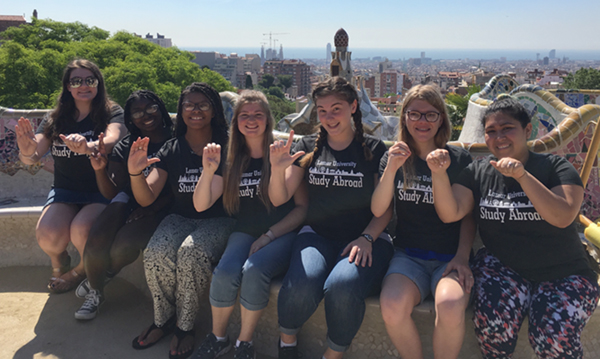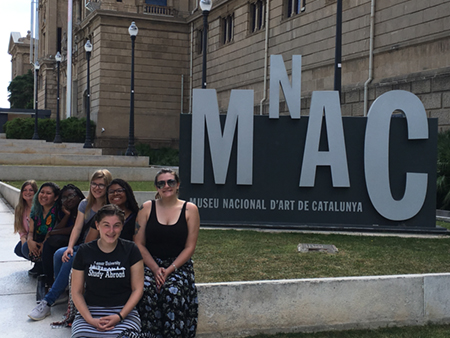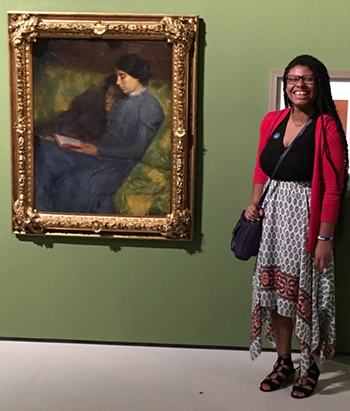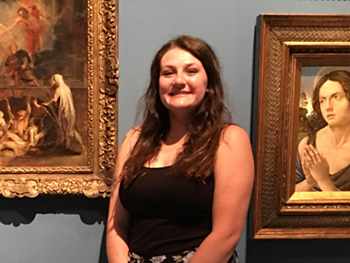Bilingual in Barcelona: LU students expand ASL proficiency in experiential learning
 The bilingual culture of Barcelona provided new bonds in learning for eight Lamar University Deaf Studies/Deaf Education students who participated in a Study Abroad trip this summer.
The bilingual culture of Barcelona provided new bonds in learning for eight Lamar University Deaf Studies/Deaf Education students who participated in a Study Abroad trip this summer.
“In an effort to cultivate a society of global learners, it is our mission to expose students to the culture and linguistic values of signing deaf communities around the world,” said Cain Chiasson, an adjunct instructor in Lamar University’s Department of Deaf Studies and Deaf Education.
Each new study abroad experience strengthens students’ connection to the American Deaf Community and promotes leadership in deaf societies across the world, Chiasson said. The trip covered two courses, “Interpreting and Tourism,” and “Classification of Structure.” Chiasson, who is pursuing an Ed.D. in Deaf Studies from Lamar University, teaches interpreter training, is fluent in French and Spanish, and has worked as a professional interpreter and translator.
 “Barcelona has a strong bilingual atmosphere,” Chiasson said. “Barcelona utilizes a philosophy of bilingual education, which is mirrored by the Deaf Studies/Deaf Education programs at Lamar University. ASL and English are taught simultaneously in the classroom.”
“Barcelona has a strong bilingual atmosphere,” Chiasson said. “Barcelona utilizes a philosophy of bilingual education, which is mirrored by the Deaf Studies/Deaf Education programs at Lamar University. ASL and English are taught simultaneously in the classroom.”
Participating in the program were ASL majors Audrey Misner of Bayou Vista, Riquerra Broadnax of Missouri City, Joya Polk of Spring, Samantha Dwiggins of Liberty, Mandane Sweeten of Austin, Erica Haase of Sugarland, and Giselle Hernandez of Houston.
“This trip provided a good opportunity to be exposed to a bilingual environment and a bilingual culture,” he said. Many LU students are training to become Deaf Education teachers, ASL teachers or ASL interpreters. During the trip, the group was able to “compare the bilingual education and bilingual things in and around us.”
“ASL production proficiency strongly relies on prior knowledge and authentic experiences,” he said. “Access to global learning also expands students’ awareness of historic sites and magnifies their appreciation and understanding of language etymology. Additionally, this field study provided a practical application of linguistic theories and historical references that students can use in the future.”

“American Sign Language is a visual, three-dimensional language, so we took two-dimensional objects and represented them in a three-dimensional language,” Chiasson said of time the group visited a museum to observe paintings or pictures in the 2D environment and had to represent them in 3D fashion. Visiting museums in Barcelona also gave the students more authentic experience in interpreting tours.
“The nature of ASL can be both two-dimensional and three-dimensional,” he said. “We work well in the three-dimensional realm, but it’s a challenge for students so I wanted to challenge them to take things from that 2D world, from what is flat, and build it out as they described in using ASL.”
Spain has played a significant role in the history of sign language education and advocacy, he said.
Spanish culture became the birthplace of fingerspelling, which has become an essential component of American Sign Language, when Melchor de Yerba published the fingerspelled alphabet in 1593. Benedictine monks incorporated fingerspelling into use. Ponce de Leon and Juan Pablo Bonet, who used fingerspelling, speechreading and signs to teach deaf children. These individuals influenced fingerspelling across countries and across cultures.
 Interpretation in tourism is one of Chiasson’s specialties and so the group was “able to do a lot in the realm of interpreting in tourism.”
Interpretation in tourism is one of Chiasson’s specialties and so the group was “able to do a lot in the realm of interpreting in tourism.”
Interpreters in Europe typically play a much larger role than their U.S. counterparts, Chiasson said. In Europe, they go beyond interpreting to acting as tour guides, event coordinators, help navigate any challenges that arise, and more.
“I learned a lot about interpreting tourism and everything that has to be done,” said junior ASL major Erica Haase. “I learned how difficult it can be if you don’t go to a place and see it before you have to interpret. This trip was the first time I have personally used interpreters and the experience was amazing.”
"The most significant thing about this trip was the fact that I got to travel in a small group and truly focus on developing my skills as an interpreter in specific techniques and practice them daily," said senior ASL major Joya Polk, who plans to become an interpreter. "I was truly challenged on this trip and it helped me grow exponentially."
She learned that "it's okay to be different from other interpreters. Being confident in your interpretation is key, and don't give up ... get used to being a lifelong learner in this profession!"
Study abroad and specialty courses can help solidify a student’s career goals, or help them decide on a different path, he said. Of this group, three students had never flown before, one who had never left Texas, and several others who had not been outside the U.S.
“This has been an eye-opening experience for many of them,” Chiasson said.

